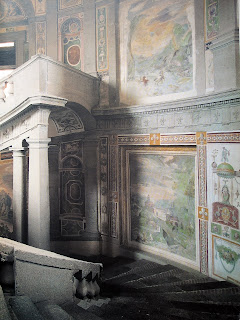Well, I was going to start this post by asking who hasn't painted a trellis? But then I realized that I hadn't painted a trellis.
I know they've been done a bazillion ways, but somehow I'd never done one before this project (pictured above) came along. There are examples of painted trellis dating as far back as Pompeii. I love how loosely the trees were painted here.
I also looked at Renzo Mongiardino for reference material, among others. His work is amazing. Here's his watercolor design for a trellis room. I highly recommend getting your hands on a copy of his book, though it's gotten quite pricey.
Figuring out those measurements in the semi-circular niche looks like a headache!
Of course, there's the excellent trellis-work in the murals at Schloss Schonbrunn too:
These next few hardly qualify as 'trellis', but I loved them so much I wanted to show you.
Then I looked through my books at hundreds of Historic ironwork references to find a nice central motif for the curved coves. Here are a couple of great reference images I looked at. I also posted a huge set of reference material here. You may find them useful!
Finally, I settled on this one...
I thought that the frame might look nice without all the central elements. I knew the designer would think it too fussy with the additional detail (and I didn't feel like painting it), so I removed the detail.
Next, I then created this image in Photoshop to suggest an idea for the curved cove of the ceiling.
The designer went for it.
At this point it occurred to me that I should do the whole job in Photoshop, print it on canvas and just paste it up on the ceiling. In retrospect, if I'd made a good paper template I probably could have. I made an important judgment call; I felt that my trips to the chiropractor were worth it for the extra exposure I gained by working on-site as opposed to hidden away in my artist's garret. And so I decided to paint this ceiling on site. Doing so much painting over my head, I realized the importance of being comfortable while you work: it's just a simple fact that you can't do your best work if you're in pain.
Here's how I laid out my design on the ceiling. First, paint the ceiling with the color of your trellis. In most cases, beige or green. Then glaze roughly over the surface (as your Step Two), with a lighter shade. Don't finesse or worry too much about this layer, as you won't see too much of it in the end. Make it quick (think 'money').
Now lay down your trellis pattern in blue tape.
Once you've gotten your trellis design laid in in tape, paint the entire surface with your base sky color.
If you want to do a simple or clouded sky, now's your time. In my case, I wanted a blank sky with trees peeking through the trellis. I didn't care about clouds in this case; it was more about the trellis than the sky. Before peeling off my blue tape lattice, I scumbled in some background foliage, then added some rough edges to give a sense of dimension to the leaves.
Here's the sequence spelled out a little more clearly: First, paint the entire wall surface with your trellis base color.
Now add a scumbled glaze layer on top.
Now add your trellis design in blue tape.
Then paint the entire surface with your sky color, right on top of the blue tape. At this point you could just add a scumbled light layer on top of your base sky tone, like this...
If you wanted to end it here, you could just peel off your blue tape, which would give you a look like this;
Instead, I wanted a trellis that showed foliage behind, so I started painting leaves and plants before I pulled my blue tape;
Once you're satisfied with the background, pull your tape. You're now ready to start painting your shadows and highlights on the trellis itself.
I like to paint a drop shadow, though I know it's not strictly accurate in this case because there wouldn't really be a shadow thrown onto the foliage like that. Still, I feel that it gives my trellis extra dimension.
As a finishing touch, you could paint some leaves or blades of grass coming through the lattice work. This will bring your background forward, and make it feel a little more integrated. A unifying over-glaze on the entire surface at this point will also help to soften the overall look of your mural.
And there you have it!



































































































